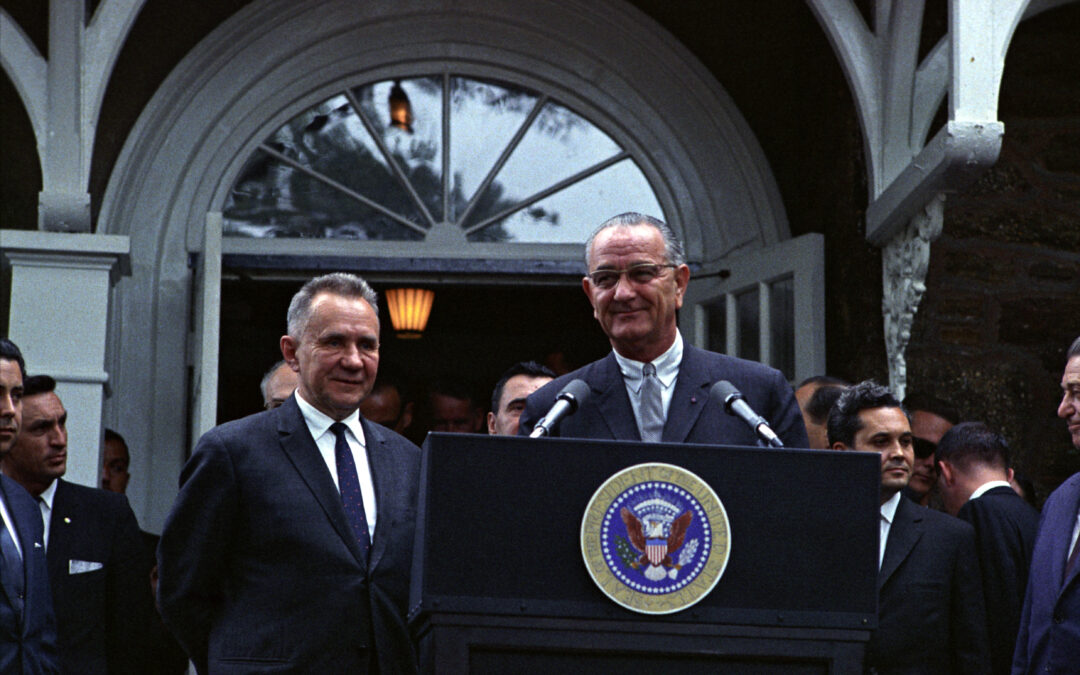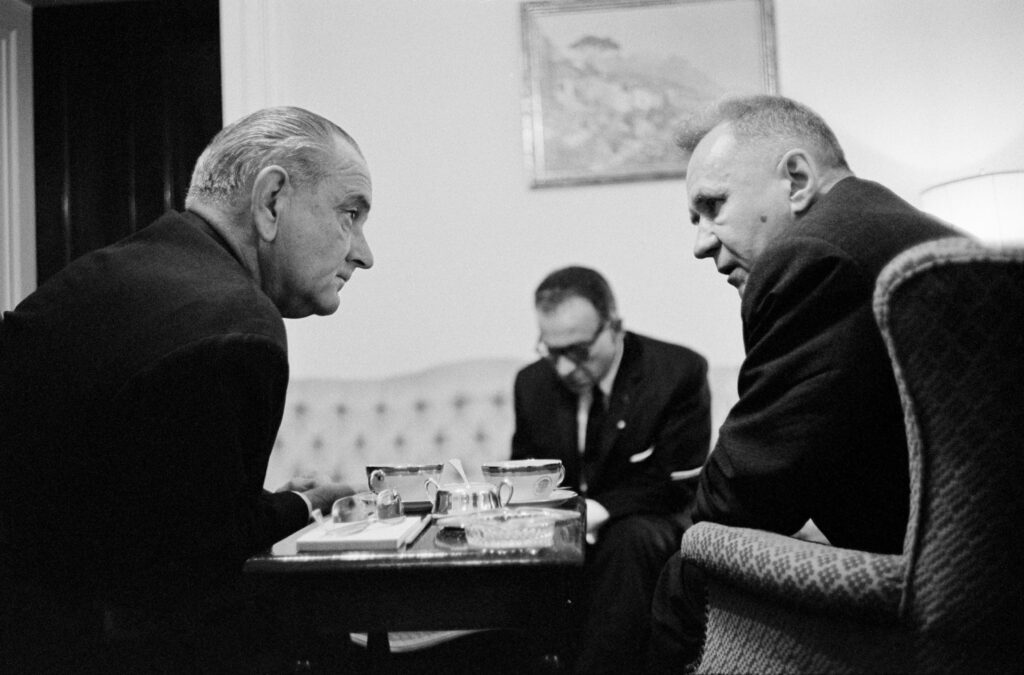
Photo courtesy of Rowan University
In the summer of 1967, on the campus of the former Glassboro State College, the “Spirit of Glassboro” was forged in the fire of international relations.
It was the height of the Vietnam War, and the United States was losing ground in the conflict. The Cold War initiated a supremely complicated relationship between the superpowers United States and Russia, among a series of other conflicts and confrontations during the same time period. The recent conclusion of the Six-Day War in the Middle East muddled the already tense relationship between the countries.
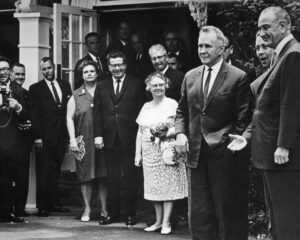 But, for a brief moment, in a small, southern New Jersey town, there was amiability between two of the most powerful people in the world.
But, for a brief moment, in a small, southern New Jersey town, there was amiability between two of the most powerful people in the world.
From June 23 to June 25, 1967, President Lyndon B. Johnson and Premier Alexei Kosygin of the Soviet Union met at the Whitney Mansion for the Glassboro Summit Conference, on the campus of what is now Rowan University.
It was there that the “Spirit of Glassboro” was hammered out between the two men, owing its mythical name to the amicable atmosphere of the summit.
When the two figures decided to meet, it almost was a surprise. Kosygin traveled to New York to address the United Nations, and there he was encouraged to meet with President Johnson.
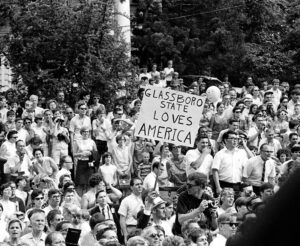
Photo courtesy of Rowan University
However, Kosygin did not want to meet in Washington, D.C., and Johnson was unwilling to travel to New York — both men stayed steadfast. The leaders had opposing views on both the Vietnam War and the Six-Day War, which had recently ended on June 11.
A compromise was made, and the meeting was planned at the halfway point of Glassboro, under the suggestion of then-New Jersey governor Richard Hughes.
Unfortunately for the borough of Glassboro, time was ticking. They had only 16 hours to prepare for the two leaders to visit for the summit.
The Whitney Mansion, or Hollybush as it was known at the time, was the residence of the president of Glassboro State College. However, it was soon transformed into a meeting place for the world leaders to sit down and talk shop.
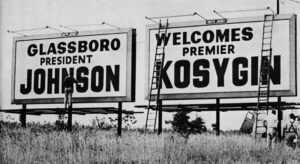 “Indeed, Glassboro was a very atypical place to hold a summit,” said Dr. James Heinzen, director of the Hollybush Institute. “In fact, this was the first time a superpower summit was held in a normal, American community, never mind on a college campus, rather than at the White House or Camp David.”
“Indeed, Glassboro was a very atypical place to hold a summit,” said Dr. James Heinzen, director of the Hollybush Institute. “In fact, this was the first time a superpower summit was held in a normal, American community, never mind on a college campus, rather than at the White House or Camp David.”
Preparations needed to be made, and they were made quickly as Secret Service, White House staffers and local borough residents worked to secure and prepare this new, world summit meeting place. These changes included furniture and china brought in from the White House as each room was designated for the use of United States or Soviet members of the meeting.
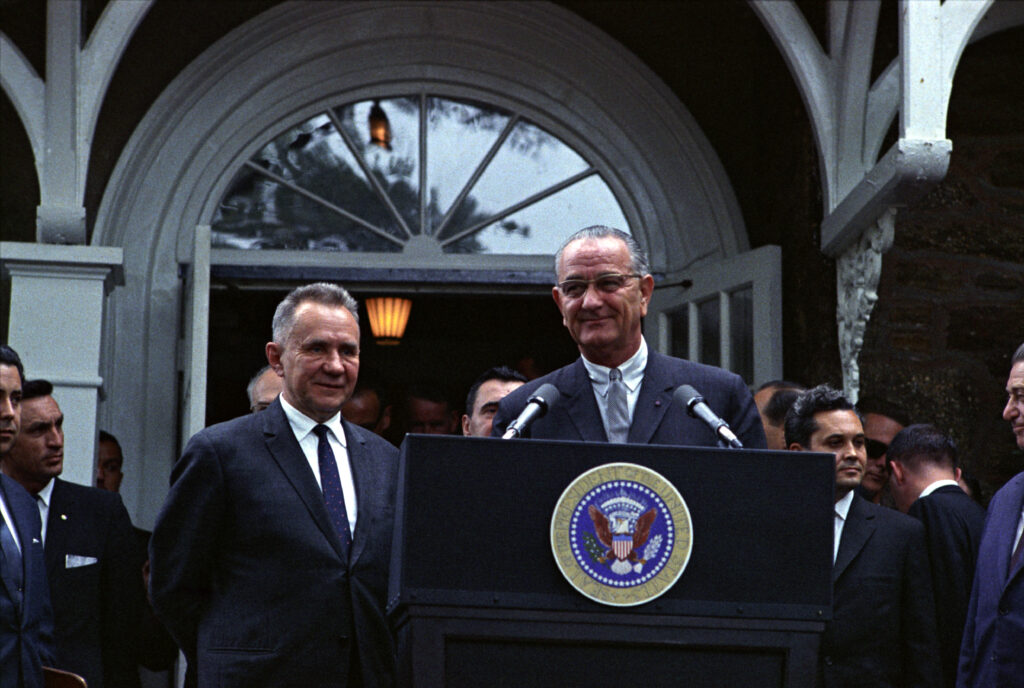
Soviet Premier Aleksei Kosygin, left, and President Lyndon B. Johnson at podium. Photo by Yoichi Okamoto
“The staff of the college and the White House pulled off an incredible feat,” Heinzen said. “I would say that the hardest part was security. John Kennedy had been murdered less than four years earlier, so there was natural concern for the safety of Johnson and Kosygin, both on the part of the American and Soviet security personnel.”
College students were mostly off campus, as it was the summer, but those on campus would be surprised when met by the Secret Service asking for an ID. Sharpshooters were placed on the top of every building, and the buildings had to be cleared of safety threats.
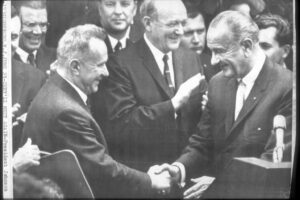
Photo courtesy of Rowan University
However, probably the biggest addition to Hollybush was the installation of air conditioning in the mansion. Only two other buildings on the Glassboro State campus had air conditioning, but aides feared that the heat in the historic Victorian mansion would bother Kosygin and upset the hopefully productive talks.
Crowds of thousands gathered on the street, cheering for the visit of these two men and holding up signs showing their support. A large set of two signs entering town read “Glassboro Welcomes President Johnson and Premier Kosygin.”
“The town reacted amazingly well and quickly,” Heinzen said. “Local restaurants provided food for the press, the police and Secret Service, the college staff, and the delegations in Hollybush. People were very welcoming of the Russian delegation and Lyndon Johnson, as the photos of all the people in the streets outside the mansion show.”
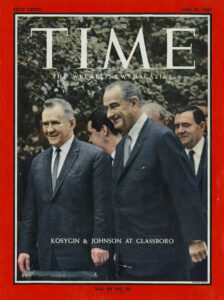 Heinzen said the local movie theater showcased the film, “The Russians are Coming! The Russians are Coming!” about Soviet sailors who accidentally washed up on the shores of coastal Maine.
Heinzen said the local movie theater showcased the film, “The Russians are Coming! The Russians are Coming!” about Soviet sailors who accidentally washed up on the shores of coastal Maine.
Media from around the country gathered as well, including almost 1,000 journalists and names such as journalist Dan Rather, while the Esbjornson Gym on campus became the hustling and bustling media center.
“The other hard part was communications,” Heinzen said. “There were hundreds of journalists from all over the world who had to establish phone and video connections to their home media outlets. Secure phone lines had to be set up in Hollybush for both the American and Soviet contingent. This was very difficult, as you can imagine, but they pulled it off.”
As the men stood on the steps of Hollybush in the early afternoon, they gave a press conference on their talks and what they would discuss. Then, they would head inside the mansion and begin the discussions.
The talks would last nearly 10 hours in the library, with Johnson and Kosygin discussing topics such as the opposing views on the Six-Day War, the nuclear arms race and an escalation in conflict in southeast Asia. They also discussed the Vietnam War and the prospect of limiting anti-ballistic missile systems.
After the productive day, the men chose to meet again on Sunday and continue the conversation. While the amicable attitudes persisted, the talks were less than fruitful, and no major agreements were signed, particularly involving the aforementioned missile systems.
While there was no breakthrough reached, this was the first summit between the leaders of the United States and Soviet Union since President Kennedy met Premier Nikita Khrushchev in 1961, and Johnson was mostly pleased with its outcome.
“We may have differences and difficulties ahead, but I think they will be lessened, not increased, by our new knowledge of each other,” Johnson said
So, the “Spirit of Glassboro” persisted. Johnson considered it a success and used the phrase while discussing improved relations with the Soviet Union.
“You good people of Glassboro have done your part to help us make this a significant and historic meeting,” Johnson said. “We think that this meeting has been useful, and we think it will be helpful in achieving what we all want more than anything else in the world — peace for all humankind.”
In the year following the summit in 1968, President Johnson returned to Glassboro to serve as the commencement speaker for the university’s graduating class.
He noted the good nature of the summit, believing the town would be remembered for advancing the understanding between those two countries and leaving the world, in his words, “a little more orderly than we found it.”
Today, Hollybush serves as a venue for special events on the Rowan campus. While over 50 years have passed, the “Spirit of Glassboro” still lives on, in small ways.
And, for a moment in the late 1960s, it seemed like if everyone just sat down to hash out the issues, they could be resolved.
A promise of peace and a better tomorrow hung in the balance in that small New Jersey town.
Even today, the “Spirit of Glassboro” reminds us of that promise.

